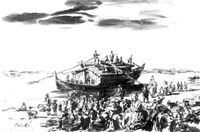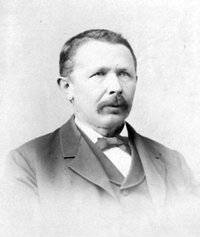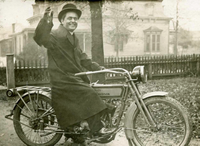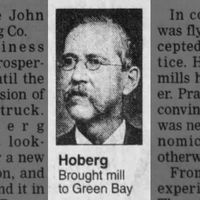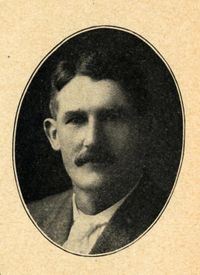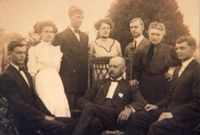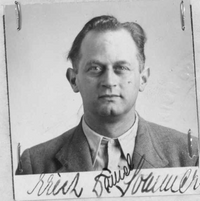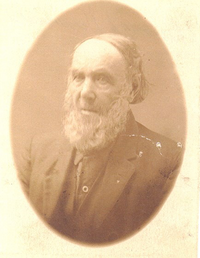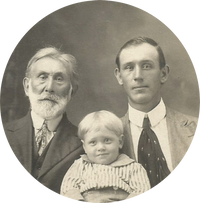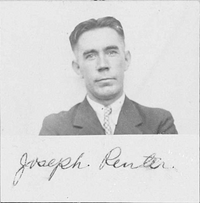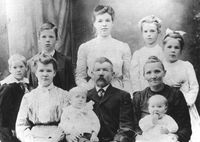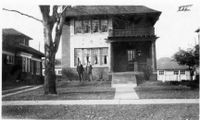Into the wide world...
... ... attracted many people. Also from the parish of Schönholthausen.
People made a start in the 18th century when they took part in the Swabian processions. Some citizens, mainly from Rönkhausen, Lenhausen and Schönholthausen, emigrated to the Banat, today's Romania.
However, the vast majority of people sought their fortune in America from the middle of the 19th century. We know that many of them found their new home here. There are also some of whom no trace remains after their arrival.
And there are one or two success stories...
Banat. Johann Bernhard Huß and his wife Elisabeth joined the first "Swabian migration" from Rönkhausen in 1724 and, as far as we know, were the first Sauerlanders to do so. According to feedback to the Imperial Court Chancellery in Vienna, they settled in Banater Pergomosch in the same year. [...] „Die ersten fanden den Tod, die zweiten die Not und erst die dritten das Brot.“[...] (read more...)
Caspar Hennecke, born on December 19, 1833 in Schönholthausen, as a military conscript, he left his Sauerland homeland in 1854 without the permission of the authorities and sought his fortune in America. Equipped with knowledge of rural housekeeping, thorough professional training in his parents' business and familiar with the typical Sauerland trading system, he repeatedly reorganized himself in various networks (including the search for gold in Pike's Peak) and thus became an important entrepreneurial personality in America.
(read more...)
Franz Anton Spanke, born on May 12, 1873 in Schönholthausen, emigrated with his parents and siblings on the ship "Strassburg" on February 16, 1881. In 1892, Franz graduated from Subiaco College, a Benedictine monastery founded in Arkansas in 1878. He was the first graduate. The following year he took his vows as a monk and was ordained a priest. From then on he went by the name Boniface. (read more...)
Johann Sr. Hoberg, born in Serkenrode on September 3, 1840, reaches the promised land of "America" with his family on the ship Louise on June 28, 1842, at the age of one. Johann founded the "Hoberg Papermill Company ltd" in Green Bay, Wisconsin, in 1895. He thus laid the foundation stone for the paper industry in the state of Wisconsin.
In 1950, the company was renamed "Charmin Paper Company". In 1957, the company is acquired by Procter & Gamble.
On July 17, 1904, Johann died in a tragic accident at work, which is still cited in accident prevention courses today. (read more...)
Heinrich Martin Arens, "..mit wehem Herzen und wenig Geld stieg an einem Augusttag 1889 ein 17 Jahre junger Mann in den Zug. Als Lenhausen und die auf dem Bahnhof winkende Mutter entschwunden waren, hatte für Heinrich Martin Arens aus Bausenrode die Fahrt nach Amerika begonnen." (Sauerlandruf Ausgabe 3/4 Dezember 1964)
Arens was a member of the Minnesota Farmers and Workers Party. Despite his German origins, he was elected to the Minnesota House of Representatives in 1919. He was a member of the House until 1922. He was then a member of the state Senate from 1923 to 1930. In 1931, he became lieutenant governor of Minnesota. From 1932, Arens was a member of the US House of Representatives for the Minnesota Farmer-Labor Party. He remained close to his native Sauerland and visited his hometown twice more after the Second World War. (Wikipedia)
Hugo Oberste, born on January 11, 1855 in Weringhausen, reached the east coast of America with his wife Maria Sprenger and their family on June 8, 1880 in Baltimore. Like many from the parish of Schönholthausen, they settle in Hartmann, Arkansas. Hugo and Maria adopt two children during the time of the "Orphan Train". Hugo was one of the leading grape growers and lumber dealers in Arkansas and a very respected resident of Arkansas.(read more...)
Erich Daniel Sommer, born 03.05.1900 in Finnentrop, died 25.10.1979 in Mercer Island, Washington.
Daniel reached the proverbial saving shore, the east coast of "America", on August 3, 1940, coming from Yokohama, Japan on the ship Hikawa Maru.
Daniel Sommer was Jewish and he probably used the last escape route for Jews from Germany in 1938. This route went from Genoa in Italy to Shanghai, China, as the city was the only place of refuge, apart from the Comoros, that accepted Jewish refugees. (read more...)
Caspar Melcher, born on 11.02.1826 in Schönholthausen and died on 13.11.1904 in Jerico Springs.
"Last Sunday morning the people of the Jericho neighborhood learned by surprise of the death of Caspar Melcher. He was one of the oldest and most respected citizens of Cedar County. On Saturday afternoon Mr. Melcher went out to the pasture to drive the horses. One of the horses kicked him and inflicted injuries from which he died the next morning..." (Obituary from November 17, 1904)
Bernard Grueneboehmer and the Oregon Trail.
Bernard was born in Lenhausen on March 31, 1840. He leaves the port of Bremen on August 1, 1868 on the steamship "New York" and arrives in New York on August 17, 1868. The Pape family from Eslohe is also on board. Shortly after their arrival, on October 27, 1868, Elisabeth Pape and Bernhard marry in Springfield, Wisconsin. They then move to Oregon and are part of the Oregon Trail. (read more...)
Three generations: Caspar J. Holthöfer, (left in the picture) born on 13.09.1835 in Serkenrode and died on 17.05.1918 in Russell, Kansas was a successful merchant in America. In the picture we see his eldest son Albert C. and his grandson Albert J. (read more...)
The original photograph is from the Albert J. Holthoefer collection, currently in possession of Pamela F. ‘Missy’ Holthoefer, 2015; used by permission.
Josef Reuter, the "Die-Maker", Born on January 18, 1896 in Schönholthausen and died on May 31, 1959 in Willoughby, Ohio. Josef emigrated from Rotterdam to New York on the "Nieuw Amsterdam" on September 9, 1922. (read more...)
Franz Baroth "Es geschah am hellichten Tag"
Franz Anton Baroth, born on 20.04.1851 in Glinge and died on 18.05.1925 in Erie, Pennsylvania, United States. Franz Anton Baroth reached his destination on 31.05.1882 together with his wife Elisabeth Baroth née Baroth and their son Franz Joseph.(read more...)
2977 Cadillac Ave., Detroit, Wayne County, Michigan
Especially in the 1920s and 30s, one of the main reasons for emigration was the so-called "pull" effect. In the discussion of emigration, a "pull" effect occurs when an emigrant is drawn to America. This was often the case when a close relative urged the emigrant to come to America.
For Schönholthausen it was Anna Maria Catharina Reuter, born on May 31, 1854, who emigrated on February 9, 1879. On August 2, 1881, she married Alois Krug, who came from Bavaria. And from then on she is "Aunt Mary Krug". (read more...)
